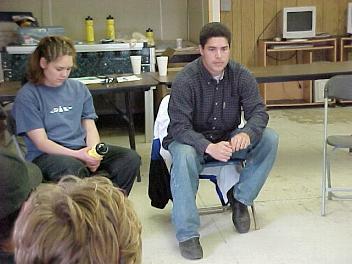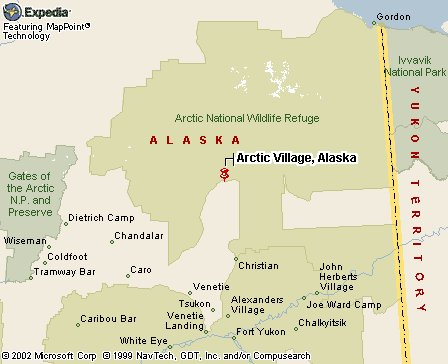|
|
Canku Ota |
|
|
(Many Paths) |
||
|
An Online Newsletter Celebrating Native America |
||
|
February 8, 2003 - Issue 80 |
||
|
|
||
|
Indigenous Peoples of Alaska |
||
|
Written by Chief Evon Peter
A Publication of Native Movement |
||
|
Our place as human beings in the world is out of balance. Through our greed, fear, and over-consumption, we have hurt many relationships between one another and our relationship with the earth. Our path as humankind needs to be altered to incorporate values of respect, unity, and balance. At least seven Nations of people, each possessing a distinct language, culture, history, spirituality, and land base inhabit the land of Alaska. They are called the Athabascan, Iñupiat, Yup'ik, Tlingit, Haida, Aleut, and Tsimpshian Nations. They are the original peoples of the land -- the Indigenous Peoples of Alaska. These Indigenous Nations, like many others in the past several hundred years, fell prey to the European Nations as they embarked on their process of colonization. Based on human greed for wealth and power this process resulted in the break down of relations between many Nations of human beings all around the world. This is the story of how colonization came to the Indigenous Peoples of Alaska. Alaska was being approached from both the east and west. The British, French, and Spanish were on their way towards Alaska from the east, already having encountered the Indigenous Nations of the Mayans, Incas, Iroqouis, Cherokee, and Navajo among many others. From the west, a Russian man named Vitus Bering was sailing towards Alaska from Russia. All this was around the mid 1700's. The French came to Alaska from the northeast, bringing fiddle music, tea, crackers, tools, and booze. They came to trade for furs from the Athabascan peoples of the area. The village of Fort Yukon now sits where the Gwich'in had gathered for thousands of years to celebrate and trade. The European fur traders set up a trading post at that place. The fur traders used booze to exploit the people for the furs they sought. On his second voyage, Russian Vitus Bering landed on one of the Aleutian Islands. The Russians were also interested in furs, particularly the sea otter pelt. Sea otter pelts were worth the value of gold in China at that time. The Russians had a hard time catching the sea otters on the rough waters and therefore resorted to enslaving the Aleut people to hunt for them. The Aleut women and children were held hostage by the Russian fur traders. The Aleut men had to bring them many sea otter pelts every day in order to get to see their family. During that period the Aleuts organized two unsuccessful uprisings against the Russians. The goal of the colonizer was to claim ownership of the land and exploit the resources and Indigenous peoples wherever they went. In Alaska, the resource the colonizers were initially after was fur, later it would become wood, salmon, gold, and oil. The goal would not change but the method to exploit would adapt to be appropriate with the times. In the case of Alaska the Russians were first, among a small group of European Nations, to claim that Alaska was their territory. None of the Indigenous Nations of Alaska participated in that claim. At that time in history Indigenous Peoples were looked at as being less than human, so we were not included in discussions about our own lands. Later, the Russians were defeated in battles by both the Tlingit and Ahtna Nations during their stay in Alaska. The Russian claim to Alaska would be equivalent to the Indigenous Nations of Alaska laying claim to a European nation, such as England or France, without that nations consent or awareness. It is a ludicrous thought, yet that is what happened with the Indigenous Nations in Alaska. By the mid 1800's, the Russians were worried that the Americans of European descent, who had created a new colonial government called the United States of America, would try to forcefully take Alaska in their westward expansion. The Russians met with the United States and in 1867 signed an agreement called the Treaty of Cession, wherein the United States paid Russia a few cents per acre for the land in Alaska. The Russian claim to ownership of all the land in Alaska and their right to sell the land through the Treaty of Cession was illegitimate for at least two reasons. The first is that the Indigenous Nations of Alaska, who are the true land holders, did not participate in the discussions or negotiations. The second is that the Russians had been defeated in battle and confined to a few trading posts. At most, the Russians had claim to those trading posts and the few acres of land they rested upon.
Our people took care of these military convoys as they came through our homelands. We treated them with the hospitality that our cultures are known for presenting to guests. In one instance, Chief Sesui and his people saved a whole convoy by finding, feeding, clothing, and guiding them to the Yukon. He was later highly recognized by the United States military for his leadership. After concluding that the Indigenous Peoples were not a hostile threat, the United States proceeded with the colonial process. The government worked to assimilate our peoples through the eradication of our Native knowledge, philosophy, languages, spiritual practices and beliefs. In some places teachers had to eradicate both the Native and Russian languages. There are reports of poison being applied to the tongues of children if they used any language other than English. The Indigenous Peoples were not allowed to participate or highly discouraged from being a part of colonial activities in Alaska. This included prohibitions on land ownership, business development, and even shopping in stores. There were signs that read "No dogs, No natives" allowed on some buildings. The United States and its people were after control of our land and resources. They had to deal with what they called the "Indian problem". They had tried massacres, treaties, and reservations in the continental United States and those methods either didn't work well or were politically unacceptable. So in Alaska, they worked hard on assimilating Indigenous Peoples into believing they are not who they are and that the United States control over them is legitimate. In 1959 the United States established the State of Alaska and granted it land that it never legitimately owned. Similarly, in an attempt to legitimize United States ownership of land in Alaska, Congress unilaterally enacted the Alaska Native Claims Settlement Act (ANCSA) in 1971. This legislation did not include the traditional leadership of the Indigenous Peoples and was not mutually agreed upon by the Indigenous Nations and the United States. ANCSA was a deal wherein the United States paid nearly 1 billion dollars for taking the land from Indigenous Peoples with the exception of 44 million acres. It established Indigenous run for-profit corporations to receive and manage the land and money. The Act was created to eventually lead to the loss of the remaining 44 million acres of land from Indigenous control. Although it was a struggle, the Indigenous Peoples succeeded in getting amendments to ANCSA in 1987 to protect the land and have also succeeded in keeping the corporations alive. It should also be mentioned that the Neetsaii Gwich'in from Venetie and Arctic Village refused to participate by not accepting money or corporations. The moral of this story is that control over our people, land, and resources by the State of Alaska and United States is based on illegitimate negotiations and unilateral decisions. Our people, like most other Indigenous Peoples throughout the world, are struggling for recognized rights to our land and way of life. We strive to make things better for our people while attempting to address the historical injustices that are at the foundation of many of our struggles. Based on international law, one Nation of people does not have the right to control another Nation of people. We were not initially considered Nations by the Europeans and Russians because they were not sure we were human beings. Times have changed since then and our traditional Indigenous governments have national and international recognition. The relationship between the Indigenous Peoples of Alaska and the colonial governments need to be addressed. The relationship is out of balance. Indigenous Peoples are struggling for basic human rights, quality education, and jobs. Yet, the colonial governments and European based corporations are making millions of dollars in profit from the land and resources every year. This essay is just a small glimpse into the history of relations between Indigenous Nations and colonial governments. These relationships are a significant contributing factor to the imbalance that exists in the world today. My hope is that through the sharing of an Indigenous viewpoint on history we can begin the process of healing our relations.
|
|
|
||
|
|
||
| Canku Ota is a free Newsletter celebrating Native America, its traditions and accomplishments . We do not provide subscriber or visitor names to anyone. Some articles presented in Canku Ota may contain copyright material. We have received appropriate permissions for republishing any articles. Material appearing here is distributed without profit or monetary gain to those who have expressed an interest. This is in accordance with Title 17 U.S.C. section 107. | ||
|
Canku Ota is a copyright © 2000, 2001, 2002, 2003 of Vicki Lockard and Paul Barry. |
||
 |
 |
|
|
The "Canku Ota - A Newsletter Celebrating Native America" web site and its design is the |
||
|
Copyright © 1999, 2000, 2001, 2002, 2003 of Paul C. Barry. |
||
|
All Rights Reserved. |
||
 I
want to tell a story of the Indigenous Peoples of Alaska. It is a story
seldom told, yet needs to be heard. The survival of Indigenous Peoples
and the future of mankind depend upon stories such as this reaching
the leaders and youth of the world.
I
want to tell a story of the Indigenous Peoples of Alaska. It is a story
seldom told, yet needs to be heard. The survival of Indigenous Peoples
and the future of mankind depend upon stories such as this reaching
the leaders and youth of the world.  The
United States was aware that the Indigenous Peoples in Alaska might
not accept their illegitimate deal with Russia. In the Treaty, the Indigenous
Nations of Alaska were referred to as the "uncivilized native tribes".
So, one of the first actions the United States initiated was to send
military convoys through Alaska to assess the threat Indigenous Peoples
might pose to them. They counted the Native population, how many guns
we had, and how resistant we might be to their colonial activities.
The
United States was aware that the Indigenous Peoples in Alaska might
not accept their illegitimate deal with Russia. In the Treaty, the Indigenous
Nations of Alaska were referred to as the "uncivilized native tribes".
So, one of the first actions the United States initiated was to send
military convoys through Alaska to assess the threat Indigenous Peoples
might pose to them. They counted the Native population, how many guns
we had, and how resistant we might be to their colonial activities.